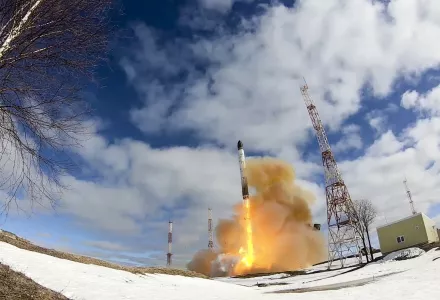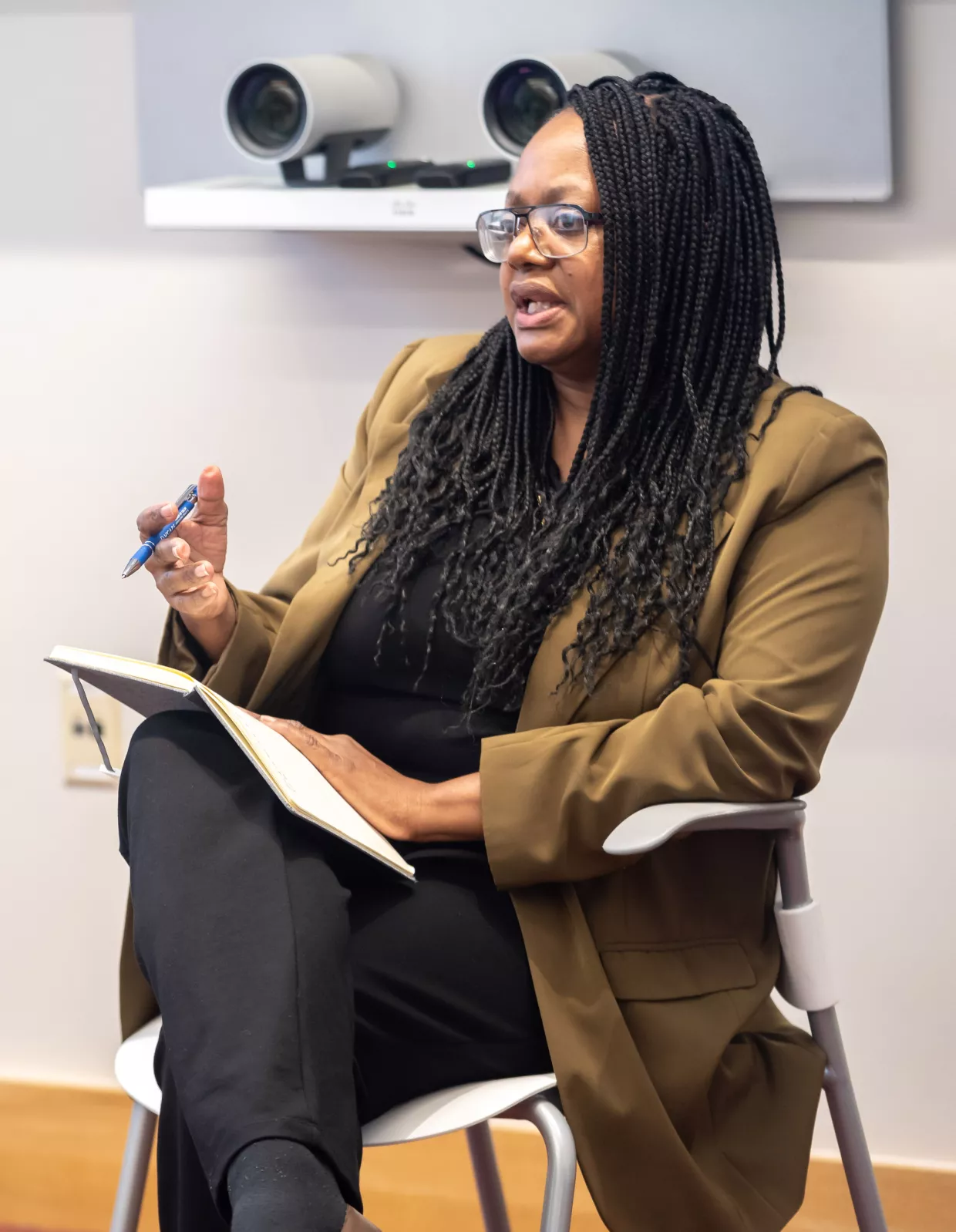
Belfer Center Launches Network on Rethinking Nuclear Deterrence
Featured in the Spring 2022 Newsletter »
The aggressive war that the Russian Federation is waging in Ukraine has rehashed fears about nuclear weapons 75 years since the first atomic bomb was used.
The Ukraine war is the first conventional war fought since WWII in Europe under the shadow of nuclear threats. The Russian Federation has the largest nuclear arsenal globally, and its nuclear doctrine envisages the possibility of using nuclear weapons first against enemies preparing to invade the country with conventional capabilities.
The global nuclear order had been in trouble for quite some time before the Ukraine war began. Since 2006, the North Korean regime has steadily advanced its nuclear capabilities to strike within the United States territory. China has been working on expanding its arsenal and dominating in critical technology fields, including space and artificial intelligence. And doubts linger on the military dimension of the Iran nuclear program. But the Russian threat over nuclear weapons in Ukraine underscores a much more severe and entrenched problem: how fragile the global nuclear balance is.
For decades, the best way to manage potential nuclear escalations has been by seeking to design nuclear deterrence postures that were credible to discourage the adversary from undertaking a surprise attack but equally intentional and cautious so as not to trigger inadvertent escalations.
The urgency of nuclear threats today raise an inevitable question: Is nuclear deterrence still appropriate in the 21st century?
Launching the Research Network on Rethinking Nuclear Deterrence
On May 10, the Belfer Center Project on Managing the Atom launched the Research Network on Rethinking Nuclear Deterrence (RNDn) to address two fundamental and interrelated questions:
- Given the deteriorating geopolitical and security landscape, how do we make sure nuclear deterrence does not fail? And,
- What alternatives can replace nuclear deterrence, and what conditions should exist to materialize them?
RNDn stands as the largest inter-institutional and inter-university consortium in the nuclear field. It consists of more than 10 universities and research centers and dozens of scholars and practitioners.
The work is divided into four main working groups:
- Preventing Nuclear Wars, co-chaired by Harvard University and India Centre for Air Power Studies.
- Ethics, Law, and Nuclear Deterrence, co-chaired by Stanford University and the University of Oxford.
- Arms Control and Emerging Technologies, co-chaired by the Center for Strategic and International Studies and the University of Hamburg.
- Beyond Nuclear Deterrence, co-chaired by Hassan Elbahtimy (King's College London, Centre for Science and Security Studies), Rebecca Davis Gibbons (University of Southern Maine, Department of Political Science), and Stephen Herzog (ETH Zurich, Center for Security Studies).
Two additional initiatives will support the academic work. A policy initiative will distribute and disseminate the main research findings across multiple policy audiences. A Brain Trust will ensure diversity of perspectives, connection with other disciplines, and rigorousness of scholarship.
The funding for the RNDn comes from the MacArthur Foundation. The decision of the Foundation before exiting the field has been to entrust MTA with its last and largest legacy gift to build a new nuclear research agenda without walls.
The research network will shape the future of nuclear studies for decades to come. It will also encourage international, inter-generational, and inter-disciplinary collaboration at an unprecedented scale.
There is much at stake if nuclear deterrence fails. We are determined not to let it happen.
Rethinking Nuclear Deterrence: What that means

The nuclear deterrence theories that continue to dominate and inform strategic thinking today were wholly designed to manage the risks of a bipolar nuclear order consisting of two blocs of internally homogeneous and ideologically distinct states. These theories were also conceived in isolation from considerations of a broader nature, including the quest for human security, social justice, inclusion, and equality.
Three-quarters of a century after the first nuclear detonations, nuclear weapons and the threat of nuclear conflict continue to cast a long shadow on global affairs. But the current nuclear age is radically different than the era in which nuclear deterrence theories were originally developed. It consists of many more players bound together by complex economic and technological interdependencies. And it interplays with other global challenges—climate change, social justice issues, violent nationalism, global pandemics in particular—of unprecedented scale.
Since the end of the Cold War, legitimate questions have been raised about how universally appropriate deterrence is as the answer to existential security risks in a world of multiple state and potentially non-state nuclear actors, extensive nuclear entanglement with non-nuclear technologies and military arrangements, terrorist groups with nuclear ambitions, and hybrid/gray zone attack that seeks to defeat or disable the adversary without necessarily going to war.
Already by 2010, senior Europeans were calling nuclear deterrence into question. In an open letter published by The Guardian in April 2010, a group of senior European statesmen and women said, “Nuclear deterrence is a far less persuasive strategic response to a world of potential regional nuclear arms races and nuclear terrorism than it was to the cold war. The circumstances of today require a shift in thinking.”
In addition, and since 2011, a coalition of non-nuclear weapons states launched a powerful initiative to explore the humanitarian consequences of nuclear weapons, claiming that any use of nuclear weapons anywhere in the globe will have catastrophic consequences on the food chain and water supply, agricultural and health infrastructures of all. The initiative later culminated in the adoption of the Treaty on the Prohibition of nuclear weapons that entered into force last February 2021. It is essential to point out that none of the nuclear weapons states or their allies participated in any negotiating sessions.
The divide has been growing between countries relying for their security on nuclear weapons and those who believe that security can only be guaranteed through a world free of nuclear weapons.
Nuclear Deterrence: Not a matter of policy but of reality
Nuclear deterrence is not a condition that you meet or a status you reach. Instead, it is a relationship between two or more nuclear states and a tool employed by states to achieve specific goals. Accordingly, it is subject to changing strategic considerations and global circumstances. It is dynamic and ever-evolving.
The concept of deterrence has deep historical roots and, thanks to the nuclear age, has been deeply developed and entrenched, especially in the existing nuclear-weapon states. Deterrence, in broad terms, is about influencing decision-making through the threat of force to discourage an opponent from taking an undesired action. This can be achieved through the threat of retaliation (deterrence by punishment) or by denying the opponent’s aims (deterrence by denial), or both.
The concept of nuclear deterrence—equally theoretically parsimonious and morally perplexing—has been historically contested and highly disputed. States rely on nuclear deterrence when, to intimidate an enemy, they threaten the use of weapons of mass and indiscriminate destructive power—nuclear weapons—and potentially on a scale that could produce catastrophic global carnage.
Frank Gavin observed: "During the period of intense Soviet-U.S. rivalry, some questioned whether the benefits of nuclear deterrence were worth the terrifying risk that nuclear weapons could be launched, either intentionally or by accident. On balance, however, the recent memory of a catastrophic great power war, within an international system marked by a bitter ideological clash, deep mistrust, and intense security competition made the possibility that nuclear deterrence could provide stability and decrease if not eliminate the prospect of total war appealing[1].
Contestation to the concept of nuclear deterrence also led to the creation of powerful schools of thought regarding nuclear weapons. The first urged the United States to seek to maintain a qualitative technological edge and to prepare for nuclear warfighting. The second advocated for a more restrained nuclear posture and bilateral and multilateral agreements to constrain dangerous forms of nuclear competition. The third argued for complete nuclear disarmament given human fallibility, the catastrophic impacts of nuclear weapons, and the precarity of nuclear deterrence.
Even though unsatisfactory and at least debatable, nuclear deterrence offered a way to navigate through dangerous nuclear war inclinations and uncompromising disarmament aspirations. And however frightening and risky, in fact, nuclear deterrence had, according to many policymakers and scholars, some positive effects in reducing the risk of war during the Cold War. In one of his seminal works, Scott Sagan remarks, “Relying on nuclear deterrence to maintain peace is like skating on thin ice. The fact that you have done it before does not mean you should expect to be able to do it safely forever.”[2].
[1] Frank Gavin, Beyond Deterrence: U.S. Nuclear Statecraft Since 1945, American Academy of Arts and Sciences Occasional Paper, February 2018, p. 1
[2] Scott Sagan, The Limits of Safety, Princeton University Press; 1st edition (January 9, 1995), p. xx
The Role of Nuclear Weapons in the 21st Century: Belfer Center Launches Network on Rethinking Nuclear Deterrence.” Belfer Center Newsletter, Belfer Center for Science and International Affairs, Harvard Kennedy School. (Spring 2022)





